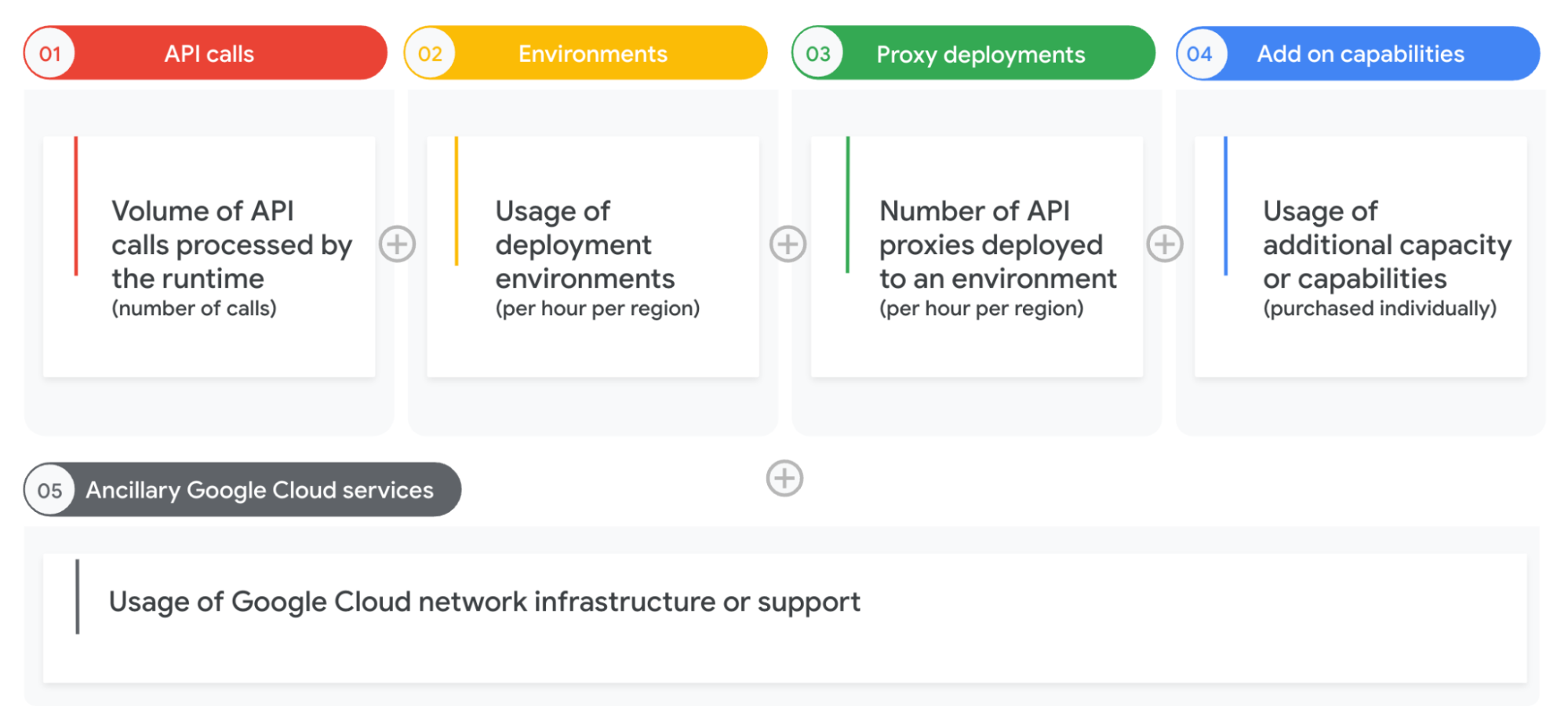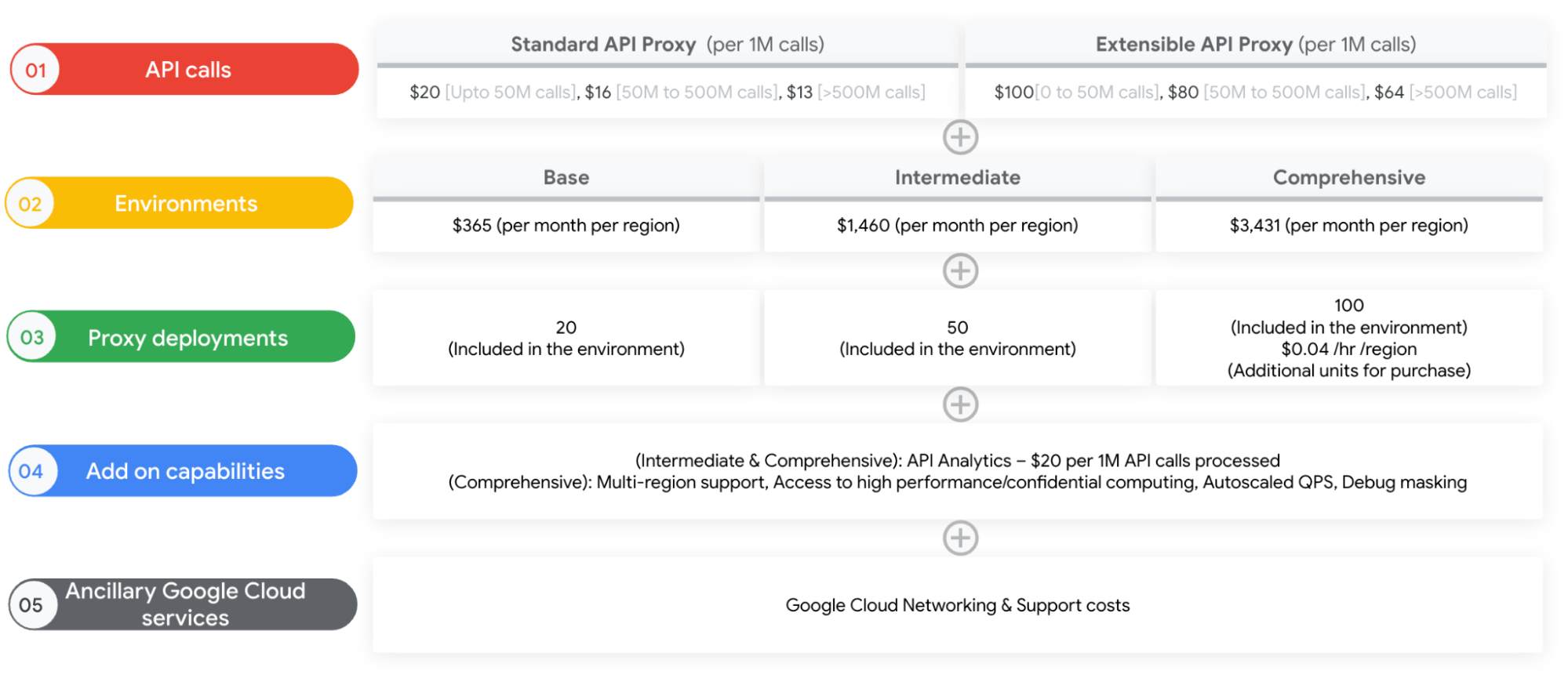Today’s application and integration landscape has ushered in an unprecedented proliferation of APIs. Already, more than 90% of developers use APIs with everything from small-scale apps to mission-critical operations. As a result, organizations often find themselves juggling multiple API gateways, leading to operational, security, and maintenance overhead. So it’s no surprise that a one-size-fits-all approach API management doesn’t meet most organizations’ needs.
To better address customer needs, we introduced Pay-as-you-go pricing for Apigee in August 2022, allowing customers to flexibly manage their API management costs. While adoption has been strong, customers also tell us they would like to onboard at a lower cost and have more flexibility to rightsize their ongoing expenses with their usage.
Today, we’re excited to announce updates to our pricing models, which will ensure:
- Consistent pricing attributes across Apigee Pay-as-you-go and Subscription models
- Increased granularity in Pay-as-you-go pricing
With these enhancements, you can now accurately tailor your expenses according to your Pay-as-you-go usage and easily shift to Subscription pricing as your needs scale.
Consistent pricing attributes across Pay-as-you-go and Subscription
Going forward, we’ll use the same pricing attributes for both Pay-as-you-go and Subscription pricing models. With both, you’ll be charged based on your precise use of:
- API calls, on the volume of API calls processed by the runtime
- Environments, on the usage of deployment environments per hour per region
- Proxy deployments, on the number of API proxies deployed to an environment, charged per hour per region
- Add-on capabilities: Choose and pay for additional capacity or capabilities per your requirements
- Ancillary Google Cloud services: Transparent charges for the use of Google Cloud’s network infrastructure or support

In the Pay-as-you-go pricing model, you incur charges based on your consumption of the above pricing attributes. For Subscription pricing, you receive varying levels of capacity for a given pricing attribute determined by which pricing tier (Standard, Enterprise, or Enterprise Plus) you use.
Pay-as-you-go pricing granularity
We are also refining our Pay-as-you-go pricing to offer greater granularity. This means you can start small and rightsize your ongoing expenses to align with your actual usage. Instead of a blanket charge for a full suite of API management capabilities, you’ll only pay for the subset of functionality that you actually use. Specifically, we are enabling this across two key pricing attributes:
API calls
The cost is determined by the type of API proxy that is processing an API call. We are introducing two distinct API proxies:
Standard API proxy: A lightweight proxy that operates at 1/5th the cost of Extensible API Proxy and accesses a subset of Apigee’s policies. The Standard API proxy is a fit for:
- Proxying traffic to a backend service, with minimal transformation
- Operating traffic that is low in complexity, at a fraction of the cost of Extensible API proxy (see below)
Extensible API proxy: A fully programmable proxy with unrestricted access to Apigee’s policies and capabilities. The Extensible API proxy is designed for:
- Building API products that manage traffic from multiple consumers across multiple backend services
- Simplifying intricate configurations and enforcing standards using shared flows
- Operating traffic that requires complex transformations and precision control
Calls made through the Standard API Proxy are priced at 1/5th of those made via the Extensible API Proxy.

Environments
An Apigee environment is a software environment within an organization that lets developers create and deploy an API proxy. The environment cost is determined by the type of environment an API proxy is deployed to. Today, we are introducing three distinct environments that have access to varying degrees of Apigee capabilities.
- Base: Allows you to onboard into the Apigee platform at a low cost to manage low-complexity APIs. The Base environment provides:
- The ability to deploy Standard API Proxies
- API Monitoring
- API Hub and Apigee’s development tools
- Access to other Google Cloud services
The Base environment is ideal for API use cases that require basic traffic orchestration such as prototyping, internal development, or small-scale applications
2. Intermediate: Enables you to manage a portfolio of APIs with access to various add-on functionality. The Intermediate environment provides:
- All capabilities included in the Base environment type
- The ability to deploy Extensible API Proxies
- Support for building shared flows, API products, or developer portals
- The ability purchase Analytics as an add-on capability
The Intermediate environment is a good fit for API use cases that require building and publishing API products to developers, managing a portfolio of APIs whose adoption is growing, and handling complex transformations and mediations in API traffic.
3. Comprehensive: Supports mission-critical apps and unexpected traffic spikes with high reliability and unparalleled performance. The Comprehensive environment provides:
- All capabilities included in the Intermediate environment type
- The ability to deploy to multiple regions
- The ability to purchase additional proxy deployments per environment
- Support for autoscaled QPS, Confidential and high performance computing (HPC)
The Comprehensive environment is designed for API use cases that require supporting mission-critical applications that need high reliability and performance, as well as precise control of API operations.
You can now tailor your pricing by using multiple or mixing and matching different environment types within a single Google Cloud project. You can even change between different environment types based on your needs. Here is an overall view of Apigee’s new Pay-as-you-go pricing model:

Get started with Apigee API Management
With these changes, Apigee stands out as the only solution in the market that lets you start at a lower cost and provides a clear path to full lifecycle API management. For detailed information on the new pricing models, please visit our pricing page or technical documentation. If you are not using Apigee yet, get started here.

